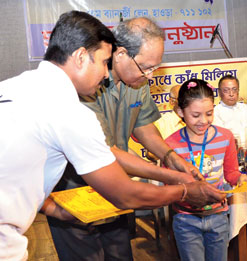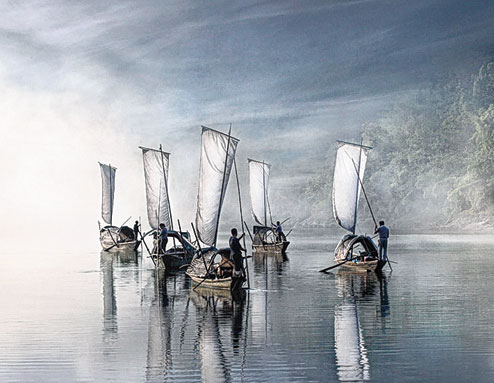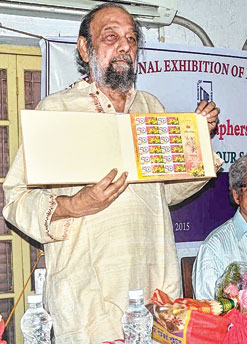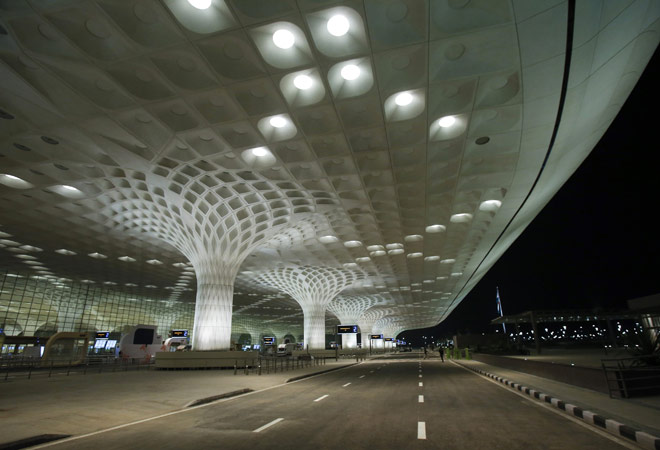Kolkata :
This is a unique story of a man not only going to the mountain, but also taking it on to realize a daring dream — that of leaving his permanent imprint on it.
The last time man attempted such a feat was nearly 14 centuries ago, at Mahabalipuram.
A similar exercise is now underway in West Bengal’s Purulia district, where a group of craftsmen, led by master sculptor Chitta Dey, are sculpting giant birds in flight on the rock face of a big hill and burrowing a network of caves inside it to create a wonder that generations to come will marvel at.
To say that the 57-year-old Dey, a graduate from the Government College of Art & Craft in Kolkata, is creating history would be too much of a cliche. The dream that Dey is pursuing with liberal help from the erstwhile Planning Commission is nothing short of the monumental projects that only kings and emperors, with enormous resources at their command, could muster the courage to undertake.
The gargantuan dimensions of the project, which he conceived in 1991, could not faze the portly Dey. “I wanted to create yet another showpiece of Indian craftsmanship for the world to appreciate. And so it had to be grand in scale. If you dream, then dream big,” he says.
The 800-foot-high hill, part of the Matha range that’s connected to the well-known Ayodhya range of hills, was chosen by Dey in 1994. “I had toured many places in Maharashtra, Uttar Pradesh and Orissa to choose a hill to sculpt my dream on in the early 1990s. Ultimately, the West Bengal government requested me to narrow down my choice to a hill in this state,” says Dey, who first came to this site, about 46km west of Purulia town near the Bengal-Jharkhand border, in 1992. Sourcing funds for the project took a lot of time, he says, adding that it was Pranab Mukherjee who was instrumental in getting the Planning Commission to sanction Rs 4.26 crore for the project.
Buddhadeb Bhattacharjee, who was the culture minister then, also helped. After getting permission to implement his dream on the hill, which is now known as ‘Pakhi Pahar’ (Bird Hill), Dey went about selling his project to the people of eight surrounding villages. “They were sceptical initially and laughed off the idea. But I persevered and ultimately, could rope in about 35 of them to undergo training in sketching and sculpting. I finally selected 24 of them for this project,” he says. These men were also trained in rock-climbing by coaches from the Himalayan Mountaineering Institute in Darjeeling.
Geologists were involved to test the nature of the rock and only after their green light did the actual work start in 2004. The first step was to paint the birds on the rock face. “That was a laborious process and we often went wrong with the dimensions. We had first planned that the smallest bird would have a wing span of 17 feet but when we painted a bird of that size on the rock face, it looked too small from even the base of the hill. Now, the smallest bird has a wing span of 55 feet and the largest one a wing span of 120 feet,” Dey says. This process took about four and a half years.
The entire project is under the aegis of Dey’s Flight To Harmony Foundation. The sculptor roped in civil and mechanical engineers to guide the team in erecting scaffoldings, fixing two 25-tonne anchor bolts on the peak of the hill to enable the craftsmen to rappel down the rock face and work and other such works.
They craftsmen wear harnesses, helmets, eye shields and take all safety measures, he says, adding that they have individual insurance policies and are covered by the workmen compensation policy as well. They are paid Rs 160 a day. Every morning, they congregate at ‘Pakhipahar Ghar’, a nondescript, three-storey house that squats at the base of the hill and is home to Dey and some of his companions, around 8am, discuss the work of the day and head to the hill around 8.30am. They work till 3pm and return to their homes after that. “We can only work from late October to March because of the extreme heat and the rain during the rest of the year,” says Upen Chandra Mahato, 35, who believes he is creating a beautiful masterpiece for posterity.
Dey took his 24-member team to the Ajanta-Ellora caves as well as Aurangabad in 2010. “That was hugely inspirational for us. We realized the importance of what we were doing,” says Mangal Ghatwal, 34. “Sir (Dey) pointed out the intricate carvings there and showed us how to achieve that fine craftsmanship. We gained a lot of confidence from the trip and felt proud that we were part of a project that would be like those caves which future generations would admire,” says Shankar Handsa, 30.
Along with the relief sculptures of birds on the rock face, the team is also chiselling away at the base of the hill to burrow 20 caves, the walls of which will have carvings of locally found animals like deer, pangolin, turtle, squirrels, peacocks and other birds as well as trees and plants indigenous to that region. “If these animals or plant species ever become extinct, future generations will know from the carvings that they once existed here,” Dey says. Many of the boulders that lie at the base of the mountain or on the way to the peak also have local flora and fauna carved on them.
About 30% of the work on this project has been completed and, says Dey, ‘Pakhi Pahar’ will start taking its proposed shape by 2020 if work continues uninterrupted. “This work has gained a momentum of its own and will continue even after I am no more. The community of local sculptors that has grown here from this project will continue the work and will hand over and further hone their skills from one generation to the next. The local community has taken ownership of the project just as I had intended,” he says.
Dey has also created another group of stakeholders in the project — six inmates of the Alipore Central Correctional Home, who were taken to the site last weekend and given the opportunity to take the chisel and make their marks on the rock face. Marks that, when viewed from afar, will look like giant birds in motion which will stand testament yet again to humankind’s enterprise and perseverance.
source: http://www.timesofindia.indiatimes.com / The Times of India / Home> City> Kolkata / by Jaideep Mazumdar, TNN / March 28th, 2015




